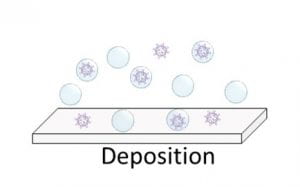Aerosol / Droplet Deposition or Loss
The science of droplets on surfaces is well established for pure fluids1, and this includes the key effects of evaporation and droplet dynamics under a variety of environmental conditions (temperature, humidity, etc.). However, as it pertains to SARS-CoV-2, much of the uncertainty derives from the complex biophysical and biochemical characteristics.
Higher level of certainty
1. Deposition onto surfaces: Respiratory droplets from individuals, especially large droplets will quickly settle (a 100 µm droplet will sediment from 1 m in 3 seconds), they are also likely to contain higher concentrations of pathogens. Viral particles can be deposited onto surfaces and resuspended via airflow patterns and other sources of natural or man-made turbulence.2–4
2. Stability on different surfaces types: The SARS-CoV-2 virus can remain viable on surfaces in the order of hours to days, with different inactivation rates depending on the surface type (copper for a few hours, cardboard a day, plastic and stainless steel, a number of days at room temp.).2,5
3. Environmental effects on droplets: Viruses within saliva droplets have marginally longer survival times than in water droplets at varied relative humidity.6 Coronaviruses survivability is reduced by half when RH is between 40-60%.2 SARS-CoV-2 is stable at lower temperatures and becomes increasingly less stable at higher temperatures and relative humidity.2,7,8 It’s half-life at 70°C is ~ 1 h, but is ~ one week at 4°C.8 Coronaviruses are known to be inactivated by sunlight and UV-C.9
4. Importance of complex physico-chemical characteristics: The evolution and dynamics of SARS-CoV-2 viral droplets must account for the complex interior structure since it exhibits many differences to pure fluids (e.g. different evaporation rates).10
Lower level of certainty
1. Uncertainties from physico-chemical characteristics: The detailed biophysical and biochemical characteristics of expelled SARS-CoV-2 droplets is not well known, and this has a significant impact on the ability to estimate dynamics. Real respiratory droplets vary widely and are difficult to study, with limited data.10
2. Drying and inactivation times: Saliva droplets dry to a highly concentrated ‘droplet nuclei’ containing glycoproteins and lipids from the body. This may provide a beneficial microenvironment, protecting virus from inactivation, some evidence is significant enough to account for discrepancy between drying time and inactivation time.6,10
3. Interactions with complex surfaces and complex environments estimations: It remains unclear how SARS-CoV-2 interacts with complex multi-scale surfaces (porous surfaces, carpets, etc.). The extent of danger of different transmission pathways (air, surface, environmental) is still unknown.4,11
4. Transfer from surfaces to skin: Viral transfer from surfaces to skin is known to happen but experimental data is not yet available for SARS-CoV-2. For modelling purposes data for other viruses (e.g. influenza, rhinovirus and norovirus) can be used.12
* The statements above are intended to be reviewed regularly as more information and new references emerge. If you have queries about the content of the above and wish to discuss these please contact the editors.
References:
- de Gennes P-G, Brochard-Wyart F, Quéré D. Capillarity and Wetting Phenomena. Springer New York; 2004. doi:10.1007/978-0-387-21656-0
- Dietz L, Horve PF, Coil DA, Fretz M, Eisen JA, Van Den Wymelenberg K. 2019 Novel Coronavirus (COVID-19) Pandemic: Built Environment Considerations To Reduce Transmission. mSystems. 2020;5(2). doi:10.1128/msystems.00245-20
- Chao CYH, Wan MP, Morawska L, et al. Characterization of expiration air jets and droplet size distributions immediately at the mouth opening. J Aerosol Sci. 2009;40(2):122-133. doi:10.1016/j.jaerosci.2008.10.003
- Ong SWX, Tan YK, Chia PY, et al. Air, Surface Environmental, and Personal Protective Equipment Contamination by Severe Acute Respiratory Syndrome Coronavirus 2 (SARS-CoV-2) From a Symptomatic Patient. Jama. Published online 2020:3-5. doi:10.1001/jama.2020.3227
- Van Doremalen N, Bushmaker T, Morris DH, et al. Aerosol and surface stability of SARS-CoV-2 as compared with SARS-CoV-1. N Engl J Med. 2020;382(16):1564-1567. doi:10.1056/NEJMc2004973
- Liu L, Wei J, Li Y, Ooi A. Evaporation and dispersion of respiratory droplets from coughing. Indoor Air. 2017;27(1):179-190. doi:10.1111/ina.12297
- Biryukov J, Boydston JA, Dunning RA, et al. Increasing temperature and relative humidity accelerates inactivation of SARS-COV-2 on surfaces. mSphere. 2020;5(4). doi:10.1128/mSphere.00441-20
- Chin AWH, Chu JTS, Perera MRA, et al. Stability of SARS-CoV-2 in different environmental conditions. The Lancet Microbe. 2020;1(1):e10. doi:10.1016/s2666-5247(20)30003-3
- Buonanno M, Welch D, Shuryak I, Brenner D. Far-UVC light efficiently and safely inactivates airborne human coronaviruses. Sci Rep . 2020;10(10285). doi:10.21203/RS.3.RS-25728/V1
- Vejerano EP, Marr LC. Physico-chemical characteristics of evaporating respiratory fluid droplets. J R Soc Interface. 2018;15(139):20170939. doi:10.1098/rsif.2017.0939
- Harbourt DE, Haddow AD, Piper AE, et al. Modeling the Stability of Severe Acute Respiratory Syndrome Coronavirus 2 (SARS-CoV-1 2) on Skin, Currency, and Clothing 2 3. medRxiv. Published online July 3, 2020:2020.07.01.20144253. doi:10.1101/2020.07.01.20144253
- Kraay ANM, Hayashi MAL, Hernandez-Ceron N, et al. Fomite-mediated transmission as a sufficient pathway: A comparative analysis across three viral pathogens 11 Medical and Health Sciences 1117 Public Health and Health Services. BMC Infect Dis. 2018;18(1):540. doi:10.1186/s12879-018-3425-x

